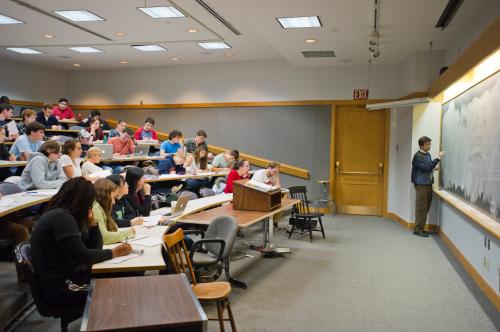A college education provides students with higher employment prospects and social mobility. Yet, college enrollments are declining despite many federal and state efforts to encourage more college-going in recent decades.
Why isn’t college working for more young people? Especially with stubbornly persistent income-based gaps in college completion, higher education leaders are scrutinizing many facets of the college experience to remove barriers for disadvantaged students. This includes asking if the ways that colleges traditionally grade and calculate students’ GPAs might deter students from persisting in college. Students often feel the need to maintain a good GPA, but this motivation might have adverse consequences on their choices during their college experience.
Could more forgiving or lenient grading policies promote more student success? This is the question that motivated our recent work. An increasingly common college academic policy, grade forgiveness (or sometimes called grade replacement) allows students who retake courses to replace the old grades with the new grades in GPA calculations. Contrast this with the more traditional practice in GPA calculations, which takes the average of the new and the old grades for repeated courses.
This relatively lenient policy of “erasing” the old grade is widely used but controversial in higher ed circles. The most common criticism is that students might not work as hard the first time around when grades can be forgiven. But proponents argue that many early-stage students struggle to thrive in college, and a more forgiving policy might lead to greater resilience in students and ultimately improve success. This could be especially helpful with encouraging students to persist in STEM courses, which have rigorous grading standards but lead to high-paying careers. Both arguments are theoretically sensible and are ultimately empirical questions that prior work has not fully settled.
Evidence from grade-forgiveness reforms at Boise State University
Our new paper is the first to evaluate this policy comprehensively. We do so by evaluating the effect of grade forgiveness on several key outcomes, including the decision to repeat a course, initial course choice, performance, and graduation probabilities. We use student transcript data from Boise State University. Boise State is an ideal subject because the institution underwent two major changes of their GPA policy during the time window of our data (1990-2017).
The earliest students in our data (those starting in 1990) entered Boise State with a grade-forgiveness policy in place. That changed to a more traditional grade-averaging policy in 1995. And in 2001, Boise State reversed course and went back to the forgiveness policy once again, which has been in place since then. The multiple switches between policy regimes facilitate a two-way fixed-effects model; see the paper for full methodological details.
When looking at the experience of the many Boise State students exposed to these different policy regimes, we find several important results. To begin, we show that students are highly responsive to changes in the policy. We observed a sharp decline in the probability of repeating a course when the policy stops and a sharp increase when the policy begins.
Our theoretical approach assumes that grade-forgiveness policies influence the risk-reward balance of enrolling in any given course. In other words, before enrolling in a course, grade forgiveness offers all students a costly “insurance” against a low grade. (The cost is additional time and tuition to retake a course.) For those students who value the insurance more highly than the cost, we expect to see them more willing to take risk.
The primary outcome we look at through this risk-taking lens is students’ initial course choices, with a focus on STEM courses. We find that the grade-forgiveness policy increases the likelihood of enrolling in STEM courses by 10%. Note that this in an effect that excludes re-enrollment in STEM classes already taken. The effect is most pronounced among early-stage students and academically better-prepared students.
We also made a deeper dive into the policy’s effect on persistence in STEM by exploring later outcomes of those who repeat a course. We look at their enrollment and performance in a same-subject course taken in the following semesters. We find that repeating a course increases enrollment in other courses in that subject. Importantly, too, repeaters perform better in the next course. Together, the increase in initial interest and persistence contribute to a 25% increase in STEM graduation when grade-forgiveness policies are in place.
Grade-forgiveness impacts on underrepresented student groups
We also explore the policy’s differential effects on STEM-underrepresented groups, focusing first on gender differences. Theoretically, it is unclear whether this policy would have a stronger effect on women or men. On the one hand, women are more concerned about getting low grades, thus the harsh grading behaviors in STEM courses deter women from entering STEM majors. With the safety net provided by grade forgiveness, women might be more incentivized to take or repeat STEM courses. On the other hand, women are more risk averse, thus might be less likely nudged by this policy. Our empirical evidence shows that the policy has a positive effect for both men and women on initially enrolling in a STEM course. However, this positive effect is stronger for men than for women.
Next, we explored the differential effects between students from low- and high-income backgrounds. We find that the policy has a stronger positive effect on STEM course-taking for students from high-income backgrounds than students from low-income backgrounds. Overall, grade forgiveness increases the STEM take-up rates for all students, though it does not help the underrepresented groups more than the represented groups—despite proponents’ wishes.
We also look at changes in students’ first-attempt performance, an oft-cited concern for institutions considering the policy. We find no evidence showing students are slacking off under grade forgiveness. In particular, the least-prepared students, who are not incentivized by the policy to take more-difficult courses, do not perform any differently across the different grading regimes.
The most significant cost we find associated with grade forgiveness is the cost on time to graduation. Students who are more exposed to the grade-forgiveness policy have lower on-time graduation rates, compared to those shielded from the policy. For example, the six-year graduation rate of the cohorts who experienced grade forgiveness in their first four semesters is 10% lower than that of the cohorts who experienced no policy in any term of their first two years (though these differences in completion rates diminish with time).
Grade forgiveness is one of many institutionwide academic policies that could alter students’ college experience in subtle but significant ways. Our findings could also have generalizable policy applications, such as allowing students to take pass/fail grading options under certain scenarios, a policy taken up by many schools during the COVID-19 pandemic. While lenient policies are associated with longer times to graduation, the improvements in ultimate success and increases associated with more STEM graduates may be worth the cost.
The Brookings Institution is committed to quality, independence, and impact.
We are supported by a diverse array of funders. In line with our values and policies, each Brookings publication represents the sole views of its author(s).








